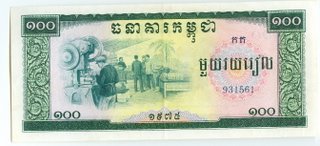Excerpts from: Memoirs of a Drugged-Up, Sex-Crazed Yippie Tales from the 1970s counter-culture: Drugs, sex, politics and rock and roll
By Steve Otto
Chapter Seventeen 1979- A changed world
“The Khmer revolution has no president. What we are trying to do has never been done before in history.”
- Ieng Sary, foreign minister of Democratic Kampuchea
The one thing I could always count on with Ian was a good political conversation, when he wasn’t trying to pick up women. On this particular winter day, I walked into the Bier Stube and found Ian and one of his friends talking about the Vietnamese invasion and occupation of Cambodia, now called Kampuchea.
“I agree with Henry Kissinger,” Ian said. “The Vietnamese did not go into Cambodia for humanitarian reasons. They went in to take advantage of the instability of Pol Pot’s government and then install a regime that would benefit them.”
“I can agree with that,” I said.
This was one of the few times that I did agree with Ian. It was ironic because I had discussed this matter with Shokrollah about a week earlier and he also agreed with Ian and me. Of course we agreed for different reasons.
In December of 1978 Vietnam invaded Democratic Kampuchea and overthrew its leaders. By January of 1979, they installed a new government, the People’s Republic of Kampuchea, headed by Heng Samrin. Pol Pot’s Democratic Kampuchea government was over. His organization was pushed out into Thailand. He and his followers formed a guerrilla army of resistance. The Vietnamese kept troops and advisors in Kampuchea to help establish the new government.
My discussion with Ian reminded me of a conversation I had had with Shokrollah about the Khmer revolution of 1975. We had just left a Friends of the Iranian People’s meeting.
“I refused to just believe what a lot of reporters in the main-stream Western press are saying,” He said. “There may be some truth to those reports, but I won’t just take their word for it. And I don’t believe they are just real vicious as the reports say. That sounds like propaganda to me.”
I finally had to agree with him that the reports deserved some skepticism. The Western press was biased enough that if no one had been killed during that government, I seriously believe the press reports would have been almost the same. I had learned to be skeptical of foreign reporting. Shokrollah was even more so.
At first, I took the press reports for their face value; that Pol Pot was really mean. He killed a lot of people and banned just about anything a person, as myself, would like to do, such as listening to rock music. But after talking to Shokrollah, I began realizing that people from third world countries might see things differently. I decided to try to see the other side. I too began to question all the horror stories and noticed that certain leaders were singled out as brutal and evil who just happened to be opponents of US foreign policy. The Shah of Iran and Chile’s Pinochet were rarely, if ever, singled out for their torture and murder of political prisoners. Only opponents of US foreign policy were. Many foreign students told me Uganda’s Amin was brutal, but he also took a stand against imperialism. It was for that stand, they said, that Western journalists and politicians focused on his human rights abuses. ………….
After gaining an appreciation for Maoist philosophy, I was intrigued with the idea of a miniature Maoist revolution in Kampuchea. I began to notice the far-left tendencies of the Communist Party of Kampuchea, which the press called
the Khmer Rouge. It was the only other Maoist revolution to succeed in the world at that time. Kampuchea’s rulers eliminated money and private property. Democratic Kampuchea seemed fiercely independent, even though it got some military aid from China. For some time, I had mixed feelings about Pol Pot. On one hand, his movement seemed to be far to the left and yet there was no justification for those executions. I was also puzzled. I was so impressed with the philosophy of Mao, I couldn’t understand how a government that tried to imitate it could produce such a disaster. It was during the Cultural Revolution that Mao and Chiang Ching broke with Marx’s view that everything is based on economics. They insisted that ideas are more important than material things. That was a view that I agreed with. How could Kampuchea go so terribly wrong?
What I didn’t realize at the time was that the Kampuchea regime was not Maoist. It had an alliance with China but the CPK considered itself an ideological rival rather than having fraternal ties with the Chinese Communist Party. China simply needed Democratic Kampuchea to counter Vietnam’s expansion. The CPK’s views on Marxism were muddled and poorly developed. Most of the ideological documents of Pol Pot and his CPK were kept secret from all those outside the party, both inside and outside the country. They began leaking out of the country starting in 1979. Most of their ideology was summed up in two documents, Decisions of the Central Committee on a Variety of Questions and The Party’s Four-Year Plan to Build Socialism in All Fields, 1977 - 1980.
By 1979, both Shokrollah and I began to see that Democratic Kampuchea had some serious problems.
“They made a lot of mistakes,” Shokrollah said one night after our meeting. “They didn’t tolerate any of the nationalist bourgeoisie, which they may have needed in the short run. They should not have arrested Sihanouk, who
was progressive and had a popular following. The fact that they fell so fast showed they lacked popular support. But that was no excuse to invade the country and occupy it as Vietnam did.”









